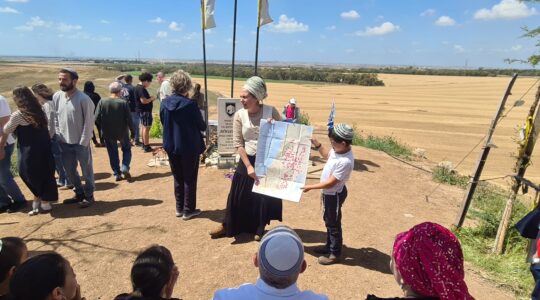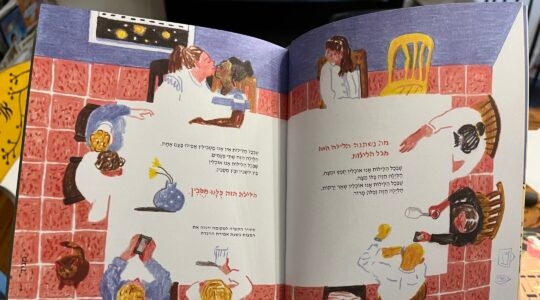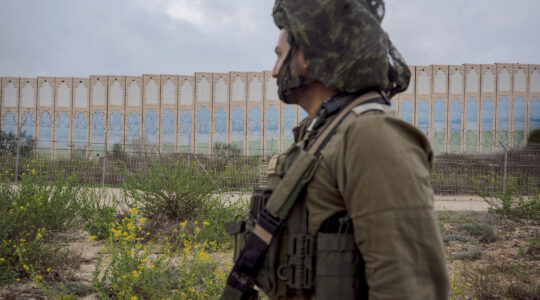RAMAT GAN, Israel (JTA) – Ruth Farhi’s eyes cloud with tears and her gaze turns from the camera recording her story as she tells of a memorable January night in 1948 that haunts her to this day.
She and a bunch of friends were crammed into her one-room rooftop apartment, sitting at the same upright piano with wooden inlay that sits just feet away from her now, singing and laughing late into the night. The revelry ended only when the 15 young men among them, all fighters in the Haganah, Israel’s pre-state militia, stood up and said their goodbyes.
Not long afterward, Farhi learned that every one of them had been killed later that night along with 20 others. It was one of the bloodiest and most painful episodes in Israel’s War of Independence. They died in an ambush by Arab villagers as they attempted to deliver supplies to a group of besieged kibbutzim. The victims became known as the Lamed Hey fighters — Hebrew for 35.
“I lived across the street from the Jewish Agency, and by the next morning the place was full of activity,” she recalled. “It was soon evident something terrible had happened.”
Farhi shared her story as part of a project called Toldot Yisrael, which aims to record on video the stories of Israeli and Diaspora Jews who witnessed or were otherwise involved with the War of Independence. The goal is to create a video archive and interactive database for educators, researchers and filmmakers.
Aryeh Halivni, who immigrated to Israel from the United States, modeled Toldot Yisrael after Steven Spielberg’s Shoah Project, which interviewed 52,000 Holocaust survivors on video.
Since the Israeli project was launched in 2007, about 500 interviews have been conducted. Among those interviewed have been prisoners of war and foot soldiers who went on to become generals, Mossad agents and politicians.
Halivni, 39, who Hebraicized his name from Eric Weisberg, told JTA he was driven in part by his own “vicarious interest of what I would have done at the time.”
He’s also driven by a sense of urgency. According to Halivni, there are about 50,000 potential interviewees still alive – those who would have been 15 or older in 1948 and were living in the country at the time. But that number is dwindling by roughly 20 percent a year as Israel’s founding generation dies off.
Add to that the growing attacks on Israel’s legitimacy, and a project like Toldot Yisrael is critically important right now, Halivni says.
“The material in this archive serves as an important reminder of the Jewish people’s legitimate right to a sovereign state in the Land of Israel, particularly at a time when that right has been called into question,” reads the project’s website. “These testimonies reinforce the positive role that Israel plays in contemporary Jewish identity and instill a renewed sense of pride and purpose in Jews throughout the world.”
Halivni adds: “This is also about being able to at least have on record stories of people who were part of it while we still can.”
To cultivate the interest of American Jews, particularly young people, in Israel’s founding story, Toldot Yisrael has begun a pilot program in several American Jewish communities to develop educational curricula based on the footage, including short films, teacher training and discussion guides. The project is partnering with the I Center, a new organization founded to develop Israel educational material.
The first film the collaboration has produced, a 10-minute short about the Jewish men who illegally blew shofars at the Western Wall on Yom Kippur in defiance of what was then British Mandate Law, has been viewed 200,000 times on YouTube.
Their newest film will come out in time for Israel’s Independence Day, which this year falls on May 10. The film describes the role of Jewish volunteers from the West who contributed to the country’s founding, including those who volunteered as sailors to help smuggle Holocaust survivors into the country by sea. It features interviews with figures like Vidal Sassoon, who fought in the Palmach militia before making his fortune in the hair care industry, and Norman Lamm, former president of Yeshiva University who was part of a factory in upstate New York that made bullets for Haganah soldiers.
“Part of what our message is that for Americans or people from the West, this is our story too — either as volunteers who came over or people involved from the United States and elsewhere who helped make things happen,” Halivni said.
In the five years the project has been conducting interviews, the nature of the interviews themselves has evolved. Rather than focusing just on the events surrounding 1948, now the personal stories of where subjects came from are delved into, often deeply.
“When we talk about aliyah or life in Europe, they are full of stories and their families’ stories,” said Peleg Levy, the project’s main cameraman. “Zionism comes from regular life stories.”
In her interview, Farhi describes being a 7-year-old girl in Vienna in 1934 and saying goodbye with her older brother to the walls and doors of their apartment as the family prepared for its journey to what was then pre-state Palestine.
“Coming by boat to the country had been the biggest drama of my life to date,” said Farhi, who would go on to become a stage and film actress in Israel.
She still recoils at the memory of arriving at the port in Jaffa and encountering the Arab dock workers who transported passengers to shore on rowboats and were notoriously rough with baggage. Some suitcases ended up tossed into the water.
“Suddenly, it seemed to me a monster came who grabbed a suitcase in one arm and me under the other, throwing me onto a little boat,” she remembered.
Farhi also describes her first memories of the “sun and the food, olives and peaches” of the country, and her first night here on the farming plot that belonged to cousins in what was then the village of Ramat Hasharon, now an upscale Tel Aviv suburb. There, she and her family were the first residents of a newly built chicken coop.
She would go on to move with her family to Haifa before becoming a teaching student in Jerusalem, where she had her fateful encounter with the Lamed Hey fighters. After the war broke out, she became a soldier in the Haganah herself, working as a telephone switchboard operator. She remembers the commanders would bark over the line, “Don’t listen!”
Returning to Haifa after the war on a visit to her parents, she did not immediately understand why the Arab family who had lived nearby was gone. As a girl, she had fed their cow scraps of watermelon and befriended their daughter.
“Once from afar I saw the mother, selling produce on a street corner,” she said. “I did not have the heart to approach her.”
JTA has documented Jewish history in real-time for over a century. Keep our journalism strong by joining us in supporting independent, award-winning reporting.





